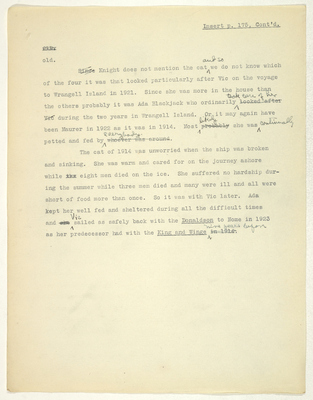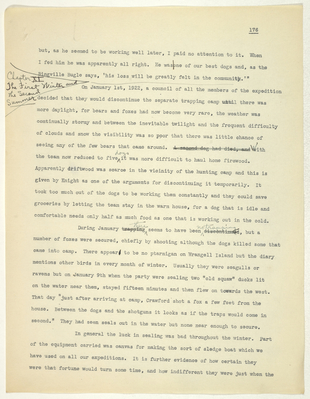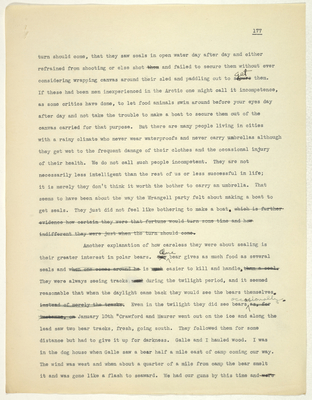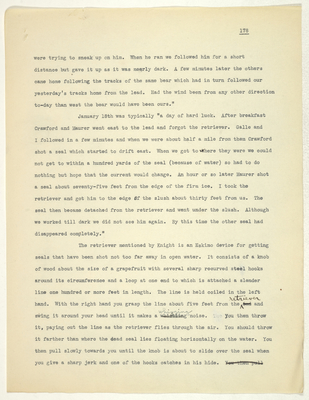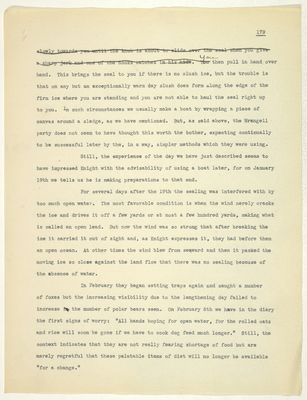Pages
stefansson-wrangel-09-29-026
Insert p. 175, Cont'd.
OLD old.
Since Knight does not mention the cat and so we do not know which of the four it was that looked particularly after Vic on the voyage to Wrangell Island in 1921. Since she was more in the house than the others probably it was Ada Blackjack who ordinarily took care of her looked after Vic during the two years in Wrangell Island. Or it may again have been Maurer in 1922 as it was in 1914. Most likely probably she was continually petted and fed by everybody. whoever was abound.
The cat of 1914 was unworried when the ship was broken and sinking. She was warm and cared for on the journey ashore while [xxx] eight men died on the ice. She suffered no hardship during the summer while three men died and many were ill and all were short of food more than once. So it was with Vic later. Ada kept her well fed and sheltered during all the difficult times and she Vic sailed as safely back with the Donaldson to Nome in 1923 as her predecessor had with the King and Winge nine years before. in 1914.
stefansson-wrangel-09-29-027
176
but, as he seemed to be working well later, I paid no attention to it. When I fed him he was apparently all right. He wasone of our best dogs and, as the Bingville Bugle says, 'his loss will be greatly felt in the community.' "
Chapter XI The First Winter and the Second Summer
On January 1st, 1922, a council of all the members of the expedition decided that they would discontinue the separate trapping camp until there was more daylight, for bears and foxes had now become very rare, the weather was continually stormy and between the inevitable twilight and the frequent difficulty of clouds and snow the visibility was so poor that there was little chance of seeing any of the few bears that came around. A second dog had died, and With the team now reduced to five dogs it was more difficult to haul home firewood. Apparently driftwood was scarce in the vicinity of the hunting camp and this is given by Knight as one of the arguments for discontinuing it temporarily. It took too much out of the dogs to be working them constantly and they could save groceries by letting the team stay in the warm house, for a dog that is idle and comfortable needs only half as much food as one that is working out in the cold.
During January trapping there seems to have been no trapping discontinued, but a number of foxes were secured, chiefly by shooting although the dogs killed some that came into camp. There appears to be no ptarmigan on Wrangell Island but the diary mentions other birds in every month of winter. Usually they were seagulls or ravens but on January 9th when the party were sealing two "old squaw" ducks lit on the water near them, stayed fifteen minutes and then flew on towards the west. That day "just after arriving at camp, Crawford shot a fox a few feet from the house. Between the dogs and the shotguns it looks as if the traps would come in second." They had seen seals out in the water but none near enough to secure.
In general the luck in sealing was bad throughout the winter. Part of the equipment carried was canvas for making the sort of sledge boat which we have used on all our expeditions. It is further evidence of how certain they were that fortune would turn some time, and how indifferent they were just when the
stefansson-wrangel-09-29-028
177
turn should come, that they saw seals in open water day after day and either refrained from shooting or else shot them and failed to secure them without ever considering wrapping canvas around their sled and paddling out to secure get them. If these had been men inexperienced in the Arctic one might call it incompetence, as some critics have done, to let food animals swim around before your eyes day after day and not take the trouble to make a boat to secure them out of the canvas carried for that purpose. But there are many people living in cities with a rainy climate who never wear waterproofs and never carry umbrellas although they get wet to the frequent damage of their clothes and the occasional injury of their health. We do not call such people incompetent. They are not necessarily less intelligent than the rest of us or less successful in life; it is merely they don't think it worth the bother to carry an umbrella. That seems to have been about the way the Wrangell party felt about making a boat to get seals. They just did not feel like bothering to make a boat. which is further evidence how certain they were that fortune would turn some time and how indifferent they were just when the turn should come.
Another explanation of how careless they were about sealing is their greater interest in polar bears. One One bear gives as much food as several seals and when one comes around he is much easier to kill and handle. than a seal. They were always seeing tracks [*»■£' ]during the twilight period, and it seemed reasonable that when the daylight came back they would see the bears themselves. instead of merely the tracks. Even in the twilight they did see bears occasionally as, far instance, on January 10th "Crawford and Maurer went out on the ice and along the lead saw two bear tracks, fresh, going south. They followed them for some distance but had to give it up for darkness. Galle and I hauled wood. I was in the dog house when Galle saw a bear half a mile east of camp coming our way. The wind was west and when about a quarter of a mile from camp the bear smelt it and was gone like a flash to seaward. We had our guns by this time and were
stefansson-wrangel-09-29-029
178
were trying to sneak up on him. When he ran we followed him for a short distance but gave it up as it was nearly dark. A few minutes later the others came home following the tracks of the same bear which had in turn followed our yesterday's tracks home from the lead. Had the wind been from any other direction to-day than west the bear would have been ours."
January 18th was typically "a day of hard luck. After breakfast Crawford and Maurer went east to the lead and forgot the retriever. Galle and I followed in a few minutes and when we were about half a mile from them Crawford shot a seal which started to drift east. When we got to twhere they were we could not get to within a hundred yards of the seal (because of water) so had to do nothing but hope that the current would change. An hour or so later Maurer shot a seal about seventy-five feet from the edge of the firm ice. I took the retriever and got him to the edge of the slush about thirty feet from us. The seal then became detached from the retriever and went under the slush. Although we worked till dark we did not see him again. By this time the other seal had disappeared completely."
The retriever mentioned by Knight is an Eskimo device for getting seals that have been shot not too far away in open water. It consists of a knob of wood about the size of a grapefruit with several sharp recurved steel hooks around its circumference and a loop at one end to which is attached a slender line one hundred or more feet in length. The line is held coiled in the left hand. With the right hand you grasp the line about five feet from the retriever end and swing it around your head until it makes a whistling whizzing noise. You then throw it, paying out the line as the retriever flies through the air. You should throw it farther than where the dead seal lies floating horizontally on the water. You then pull slowly towards you until the knob is about to slide over the seal when you give a sharp jerk and one of the hooks catches in his hide. You then pull
stefansson-wrangel-09-29-030
179
slowly towards you until the knob is about to slide over the seal when you give a sharp jerk and one of the hooks catches in his hide. You then pull in hand over hand. This brings the seal to you if there is no slush ice, but the trouble is that on any but an exceptionally warm day slush does form along the edge of the firm ice where you are standing and you are not able to haul the seal right up to you. In such circumstances we usually make a boat by wrapping a piece of canvas around a sledge, as we have mentioned. But, as said above, the Wrangell party does not seem to have thought this worth the bother, expecting continually to be successful later by the, in a way, simpler methods which they were using.
Still, the experience of the day we have just described seems to have impressed Knight with the advisability of using a boat later, for on January 19th we tells us he is making preparations to that end.
For several days after the 19th the sealing was interfered with by too much open water. The most favorable condition is when the wind merely cracks the ice and drives it off a few yards or at most a few hundred yards, making what is called an open lead. But now the wind was so strong that after breaking the ice it carried it out of sight and, as Knight expresses it, they had before them an open ocean. At other times the wind blew from seaward and then it packed the moving ice so close against the land floe that there was no sealing because of the absence of water.
In February they began setting traps again and caught a number of foxes but the increasing visibility due to the lengthening day failed to increase in the number of polar bears seen. On February 8th we have in the diary the first signs of worry: “All hands hoping for open water, for the rolled oats and rice will soon be gone if we have to cook dog feed much longer." Still, the context indicates that they are not really fearing shortage of food but are merely regretful that these palatable items of diet will no longer be available "for a change."
